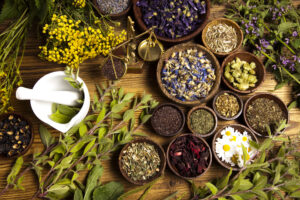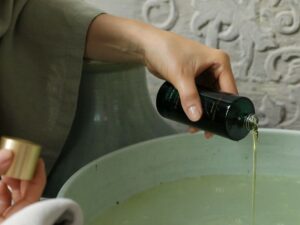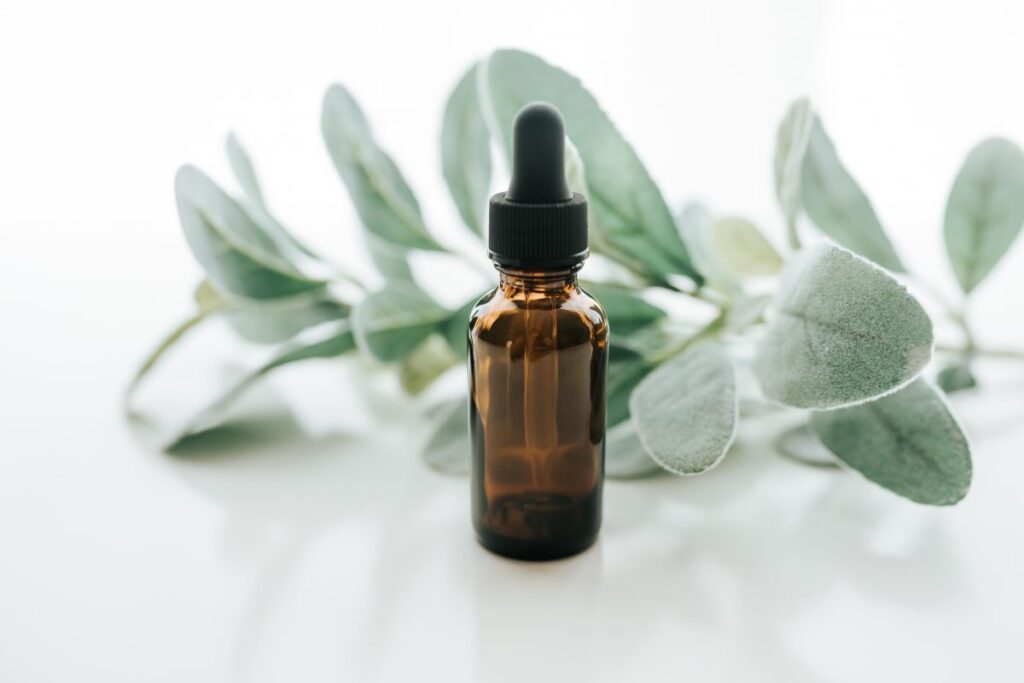What is essential oil?
Essential oil is an aromatic-concentrated liquid extracted from different parts of plants.
They are obtained from flowers, herbs, shrubs or trees.
Types of essential oils
The effect of essential oils on the human body or a certain organ, implies a kind of result of a chemical reaction that occurs through inhalation. Thus, the essential oil, consisting of hundreds of different components, getting into the human blood, begins to interact with hormones, enzymes. As a result, a person can acquire different sensations in the form of relaxation or excitement, calmness or a surge of energy.
Types of essential oils by their effect on the human body

Cleansing: orange, geranium, lavender, lemongrass, rosemary, tuberose, sage, etc.
Stimulating: bergamot, bigardia, geranium, Jasmine, ylang-ylang, cardamom, Mandarin, rose, sandalwood, etc.
Tonic: Basil, Bay, clove, ginger, cinnamon, lemon, mint, lemon balm, nutmeg, palmarosa, fir, rosemary, citronella, etc.
Relaxing: Valerian, oregano, Jasmine, lavender, frankincense, myrrh, juniper, chamomile, etc.
Harmonizing: orange, geranium, oregano, Jasmine, Mandarin, Mimosa, marjoram, rose, sandalwood, etc.
Fortifying: Basil, verbena, vetiver, Angelica, cedar, cajaput, lemon, lavender, mint, lemon balm, rosemary, etc.
Refreshing: orange, immortelle, lemon, lavender, mint, fir, etc.
Stimulating: immortelle, verbena, clove, coriander, lemon, lavender, nutmeg, juniper, mint, rosemary, black pepper, eucalyptus, etc.
Soothing: bigardia, vanilla, geranium, Jasmine, Melissa, chamomile, dill, etc.
Properties of essential oils
Most essential oils have similar properties, but each has its own exceptional qualities:
The antibacterial property is inherent in most types of essential oils. With this property, essential oils can affect different types of bacteria and fungi. These include oils of thyme, clove, oregano, anise, Basil, bergamot, lemon, grapefruit, juniper, lemongrass, etc.
Anti-inflammatory properties are also characteristic of many types of essential oils. Due to this property, essential oils are able to provide rapid regeneration of the skin in case of damage, reduce the permeability of blood vessels. Bright representatives are oils of chamomile, yarrow, bergamot, ylang-ylang, lavender, juniper, tea tree, etc.
Antiseptic properties are characteristic of many types of essential oils. It helps to effectively fight bacterial and viral infections. They are oils of marjoram, tea tree, nayoli, anise, orange, bergamot, clove, lavender, juniper, mint, petitgrain, patchouli, eucalyptus, etc.
Analgesic property, helps to eliminate various problems associated with headache, insomnia or nervous exhaustion. Such properties have oils of peppermint, lavender, blue spruce, immortelle, Jasmine, balsamic fir, etc.
Antioxidant property, helps to slow down the signs of aging, improve blood circulation and lymph flow, stimulate cellular respiration. These include oils of Dahlia, millennia, Siberian juniper, fir, etc.
Oils that contain unique phytohormones, which are similar in structure to human ones, slow down the aging process. Among them, there are oils of sandalwood, Jasmine, rose, myrrh, patchouli, neroli, etc.
Promote weight loss oils that have regulating and burning properties. The effect of them will be noticeable if you apply the courses locally, arranging a massage session, taking a bath or wrapping the problem areas. These include lemon, grapefruit, cinnamon, bergamot, tea tree, nutmeg, etc.
Regulate insomnia oils that have warming, soothing properties. These include oils of Melissa, frankincense, rose, mint, cypress, bergamot, sage, sandalwood, juniper.
Get rid of insects oils or mixtures of them that have a specific aroma that is not liked by midges or mosquitoes. The best types to eliminate annoying pests are: lavender, rosemary, eucalyptus, mint, vanilla, cloves, geraniums.
How to use essential oils
Essential oils are not just banal aromas, but real biologically active substances.
When using essential oils, learn the precautions and basic rules. First of all, choose a suitable essential oil for yourself, the smell of which you really like. Essential oil is a concentrated product, then you can not apply it to the skin in its pure form, you can get a chemical burn.
Base oils – coconut, jojoba, avocado, argan, etc. – will help to ensure a comfortable application. Before use, add a few drops of essential oil to the base oil taken as a base, and only after mixing, apply to the skin or hair.
In the care routine, essential oils can be introduced by adding a few drops to the base, for example, a face cream or base oil.

Aromatic oil bath. Before adding essential oils to the bath, you must first mix them with any base oil, milk or sea salt. This way you will avoid skin irritation and allergic reactions. The following proportions are suitable: for 1 teaspoon of base oil, add no more than 4 drops of essential oil, for example, tea tree. Or per 100 g of sea salt (milk) – up to 15 drops of a mixture of lavender and marjoram. It is allowed to stay in such a bath for no more than 15 minutes.
Hot inhalations. To implement this method, it is not necessary to purchase a special device-an inhaler. Boil the kettle and pour about 1 liter of boiling water into the prepared bowl. Then add up to 4 drops of essential oil, such as fir or a mixture of several types – fir, mint and rosemary. Use a large towel to create a protective dome over your head and breathe in the fragrant steam for 7 minutes. It is necessary to carry out such inhalations two or three times a day, one of which must be performed before bedtime.
Cold inhalations. A simple method that requires a handkerchief and essential oils. Only 2-3 drops of essential oil are applied to a handkerchief, then inhale its aromapars several times a day.
An oil burner. The simplest and most popular aromatherapy method for the treatment of colds. The aroma lamp is placed in the room in which the patient is constantly located. To implement this method, hot water is added to a glass container, and then 5 drops of essential oil, for example, eucalyptus or mint. The course of medical procedures should be carried out daily for half an hour until full recovery.
Massage. Essential oils are also used in therapeutic massage, but, as in other procedures, they are applied to the skin only pre-mixed with other oils. To do this, you will need 25 ml of any base oil, for example, olive oil, 9-10 drops of rosemary essential oil or a mixture of several essential oils – rosemary, fir and mint. Apply the mixture of oils to the skin of the back, chest and legs with long, pulling movements, while deeply inhaling the fragrant vapors. The procedure can be performed every other day.
To wash the floors, add about 35 drops of lemon, lavender or grapefruit essential oil to a bucket filled with water, and you can also add a couple of drops of tea tree oil. This solution cleans the floor well from various contaminants, while disinfecting its surface.
For washing, essential oils can be added to the washing machine. To do this, you can add 20-25 drops of rose, ylang-ylang, lemongrass, lavender or Melissa oil to the washing powder, which pleasantly aromatize bed linen and towels. For example, lemon essential oil is good at removing oily and greasy odors.
For washing dishes, essential oils with refreshing, antimicrobial properties are suitable, quickly eliminating fat and germs from its surface. For example, a few drops of essential oil of lemon, mint, tea tree, pine, eucalyptus can be mixed with the usual detergent or soda.
For disinfection. For example, tea tree essential oil is suitable, a few drops of which need to be diluted in a tablespoon of vinegar and water. The prepared solution is suitable for disinfection of kitchen shelves and drawers, sponges for washing dishes.
Essential oils that have both disinfecting and bleaching properties are suitable for cleaning sanitary ware and tiles. These include tea tree or lemon oils, which must be mixed with water, detergent, and citric acid. When applying the resulting mixture to a contaminated surface, leave the composition for a short time so that it works better, and only then rinse with water.
For aromatization, essential oils of citrus, flowers or spices are suitable, which will eliminate the unpleasant smell inside the cabinet or drawers of the chest of drawers. Apply a few drops of oil to paper napkins or pieces of wood, and then arrange them on the shelves.
To remove unpleasant odors from the surfaces of cutting boards, use essential oils of lemon, lavender, mint or tea tree, pre-mixed with soda. From the proportions: 10 drops per 100 g of soda.

